When you cook beans using solar methods, you're revealing a unique flavor intensity that comes from the sun's gradual, consistent heat. Your spices release their essential oils more effectively at temperatures up to 500°F, while steam buildup and condensation preserve the aromatics. The even heat distribution helps blend flavors naturally, and traditional techniques like blooming spices in oil or ghee distribute seasonings uniformly throughout your dish. You'll notice enhanced complexity when you add aromatics early and layer in spices as beans cook. There's a whole world of regional solar bean recipes waiting to expand your culinary horizons.
The Science Behind Solar Spicing
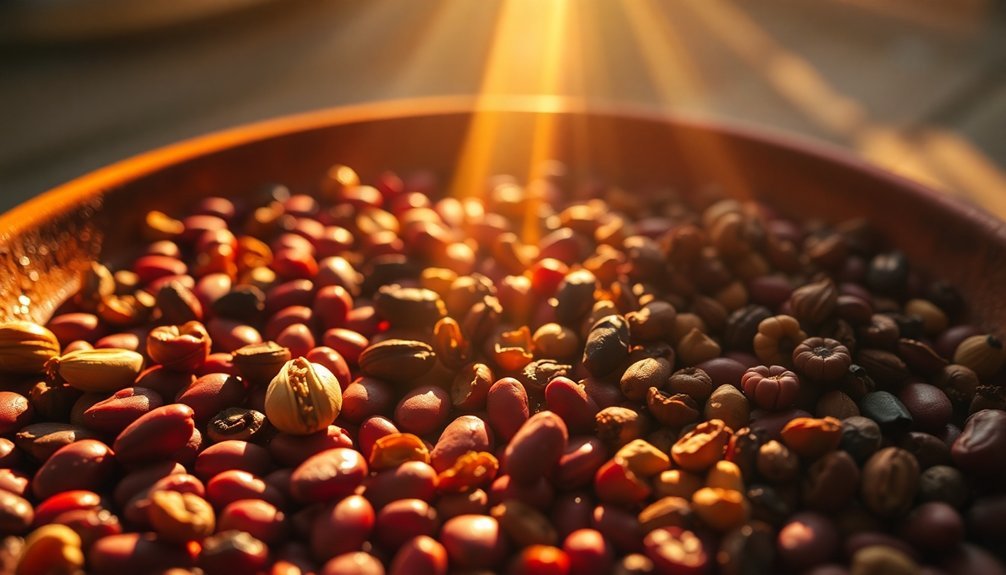
While traditional cooking methods have their place, solar spicing revolutionizes how we approach bean preparation through its unique heat distribution principles.
You'll find that parabolic cookers concentrate heat up to 500°F at their focal point, allowing spices to release their essential oils gradually and thoroughly.
When you're using a solar cooker, the slow, steady heat helps your spices infuse more deeply into pre-soaked beans.
For optimal flavor absorption, position your solar cooker during peak sunlight hours between 10 AM and 2 PM.
You'll want to use dark-colored pots and cast iron cookware to spread the heat evenly, ensuring your herbs and spices like thyme and rosemary blend seamlessly without creating flavor hot spots.
Traditional Bean Seasoning Methods
Since ancient times, traditional bean seasoning methods have centered around the essential first step of proper soaking and aromatics preparation.
You'll want to soak your beans for at least 8 hours, covering them with 2-3 inches of water and removing any that float.
To build flavor, you'll need to create a foundation with aromatics like onions, carrots, garlic, and celery.
Sautéing these ingredients in fat before adding your beans will enhance their taste and create a creamier texture. Some cooks prefer using traditional lard for authentic flavoring. You can also incorporate diverse spice profiles using ground cumin, chili powder, or regional blends like za'atar.
As you cook your beans at a low simmer, you'll need to season gradually with kosher salt and keep them submerged.
Don't forget to skim off any foam and adjust seasonings once they're done.
Heat Absorption and Flavor Release
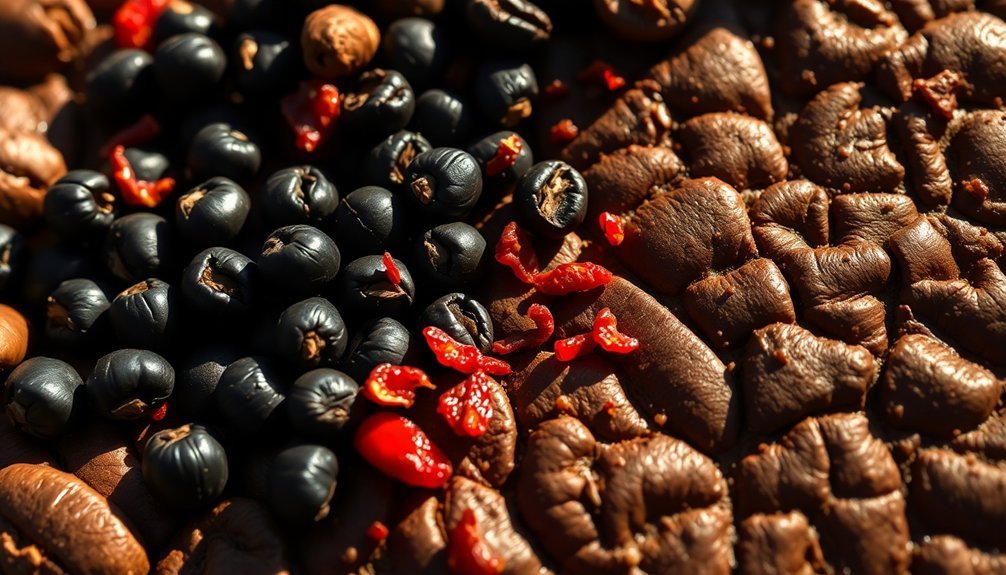
Understanding how heat activates spices can transform your bean dishes from bland to vibrant. When you apply heat to spices, their volatile oils are released, creating deeper, more complex flavors throughout your beans. Blooming spices in oil or ghee helps distribute these compounds evenly, ensuring every bite is flavorful. Navy beans absorb these enhanced flavors particularly well during their 30-45 minute cooking time.
For maximum flavor impact in your bean dishes, consider these key heating techniques:
- Dry roast whole spices like black pepper to intensify their natural oils before grinding.
- Temper ground spices in hot oil to release their aromatic compounds without burning them.
- Add spices during cooking to allow their flavors to meld with the beans completely.
The heat not only releases flavors but also triggers chemical changes – like converting gingerol in ginger to zingerone – creating new, aromatic dimensions in your dish.
Optimal Spice Timing
Mastering when to add each ingredient transforms ordinary beans into an exceptional dish.
You'll want to start by adding aromatics like garlic, onions, and bay leaves at the beginning of cooking to infuse gentle flavors throughout. Two and a half quarts of water will provide the perfect amount of liquid for two cups of dried beans.
But hold off on your spices like cumin and black pepper until the beans are nearly done – this preserves their intensity and depth.
Don't add acidic ingredients like vinegar or lemon juice until your beans are fully cooked, as early acid can make them tough and prevent proper cooking.
When it comes to salt, timing is essential: wait until the beans are barely tender before seasoning. This guarantees they'll cook evenly and develop the right texture.
You can always adjust seasonings gradually at the end to achieve your perfect flavor balance.
Regional Solar Bean Recipes
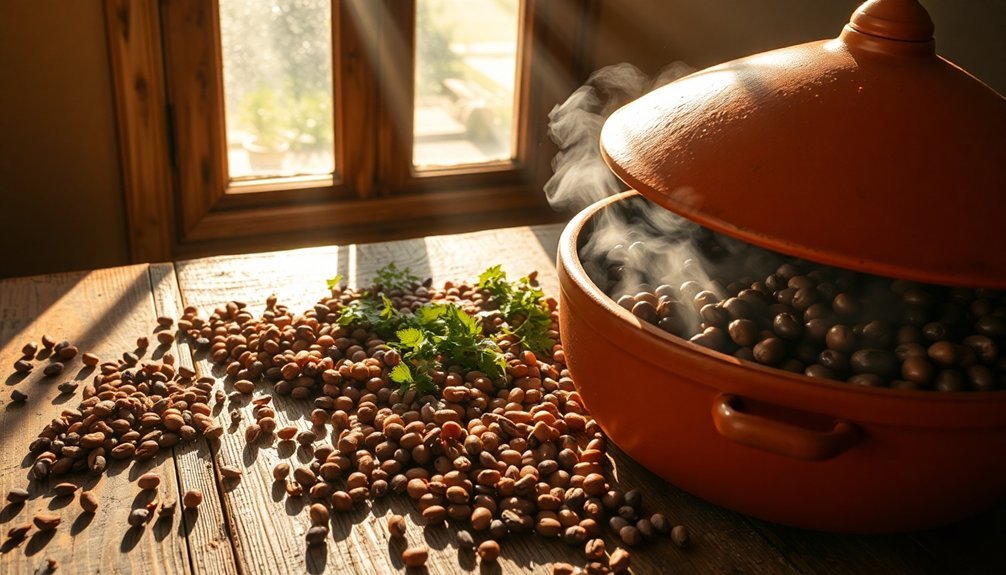
You'll find distinctly different approaches to solar bean cooking between the Southwest Desert and Mediterranean regions.
In the Southwest, you can embrace traditional spice blends of chiles, cumin, and oregano while positioning your solar cooker in the intense desert sun for ideal results.
Mediterranean methods let you incorporate olive oil, rosemary, and sage into your solar-cooked beans, taking advantage of the region's abundant sunshine and coastal breezes.
Southwest Desert Bean Traditions
Deep in the heart of the American Southwest, tepary beans tell a remarkable story of Indigenous ingenuity and culinary tradition spanning over 5,000 years. Known as *pawi* by the Tohono O'odham people, these resilient beans thrive in desert conditions where other crops can't survive.
You'll find these ancient beans bursting with flavor when prepared using traditional methods, especially when enhanced with regional aromatics.
Three key elements define authentic Southwest desert bean preparation:
- Hand-harvesting at varied maturation times to guarantee peak flavor
- Cooking with indigenous aromatics like tomatillos and Mexican oregano
- Incorporating fresh herbs and spices while respecting traditional preparation methods passed down through generations
Today, you can adapt these time-honored techniques by combining tepary beans with modern ingredients like hominy and queso fresco while maintaining their cultural significance.
Mediterranean Solar Bean Methods
While traditional Mediterranean cuisine celebrates slow-cooked beans, modern solar cooking methods have revolutionized these time-honored recipes.
You'll find that classic dishes like braised green beans with potatoes and Mediterranean bean stew adapt perfectly to solar cooking, as the steady, gentle heat helps preserve their rich flavors.
When you're preparing beans for solar cooking, you'll want to pre-soak dried varieties like Jacob's Cattle or lima beans for 12 hours.
Then combine them with Mediterranean staples like olive oil, tomatoes, and aromatic herbs such as oregano, rosemary, and thyme.
The sun's energy slowly tenderizes the beans while infusing them with garlic, onions, and vegetables.
For quicker options, you can use canned black beans seasoned with smoked paprika and cumin, letting the solar heat intensify their spices.
Aromatics in Solar Cooking
You'll find that solar cooking uniquely intensifies the aromatic compounds in your bean dishes through its gentle, steady heat distribution.
The enclosed environment of a solar cooker traps moisture effectively, helping preserve the potent flavors of spices and herbs throughout the cooking process.
This combination of solar heat and moisture retention creates an ideal environment for your aromatics to fully develop and infuse into your beans, resulting in richly flavored dishes.
Solar Heat Intensifies Aromatics
As sunlight converges on the curved surfaces of solar cookers, it creates an intense focal point of heat that dramatically enhances the aromatic properties of spices and seasonings.
You'll find that temperatures between 200°F and 300°F reveal deeper, more complex flavors as the concentrated solar energy slowly extracts essential oils from your aromatics.
The sun's steady heat helps you achieve ideal flavor development through:
- Consistent temperature control during peak hours (11 am – 3 pm)
- Gentle caramelization of natural sugars in vegetables
- Extended extraction time that allows flavors to fully develop and meld
Whether you're working with classic mirepoix or Asian trinity combinations, solar cooking's intense yet controlled heat transforms your aromatics into rich, nuanced flavor bases that'll elevate your bean dishes to new heights.
Trapped Moisture Preserves Flavors
Inside a solar oven, moisture becomes your secret weapon for preserving aromatic flavors. When you're cooking beans and spices, the trapped steam acts like a flavor vault, preventing precious aromatics from escaping. You'll notice condensation forming on the glass lid, which helps maintain temperatures between 180-250°F – perfect for extracting and preserving spice essences.
| Moisture Effect | Flavor Impact | Management Tip |
|---|---|---|
| Steam Buildup | Intensifies Spices | Vent 2-3 Seconds |
| Condensation | Preserves Aromatics | Use Tight Lids |
| Natural Juices | Enriches Beans | Dark Metal Pots |
| Even Heat | Blends Flavors | Monitor Weather |
You'll get the best results using dark, shallow pots with tight-fitting lids. When moisture builds up too much, quickly vent the oven for 2-3 seconds – you'll maintain heat while releasing excess steam that could dilute your carefully crafted flavors.
Balancing Heat and Herbs

Finding the perfect balance between heat and herbs in bean dishes depends on understanding how these flavors complement and contrast with each other.
You'll want to start with foundational aromatics like garlic and onion, then layer in your chosen spices and herbs strategically.
- Combine fresh herbs like basil and parsley for brightness, while adding woodsy herbs like rosemary and sage to create depth.
- Use chili powder and black pepper cautiously – they'll add heat without overwhelming the dish's natural flavors.
- Experiment with regional spice blends like za'atar or curry to transform your beans into globally-inspired dishes.
Don't worry about exact measurements – you can adjust herbs and spices to your taste.
Remember that cooking aromatics in fat will enhance their flavors and create a creamier texture in your final dish.
Solar Temperature Control Tips
To maintain consistent cooking temperatures when using solar heat, you'll need to closely track how heat spreads across your bean pot throughout the day.
You can fine-tune your cooking temperature by adjusting the angles of reflector panels to direct more or less sunlight onto your beans.
Since the sun's path changes with the seasons, you'll want to modify your cooking times accordingly – starting earlier during winter months and later during summer to achieve the best results.
Monitor Heat Distribution Patterns
Maintaining consistent heat distribution requires careful monitoring and strategic adjustments throughout the solar cooking process.
You'll need to reposition your solar cooker every 20-30 minutes to track the sun's movement, ensuring peak heat absorption in your bean dishes. Keep your cookware centered at the focal point while using dark-colored pots to maximize heat retention.
- Track solar peak hours between 11:00 AM and 3:00 PM for the most intense heating.
- Position thermal mass materials like bricks or stones around your cooking vessel to stabilize temperatures.
- Create an air gap beneath your pot using a wire rack for better heat circulation.
During winter months, start cooking earlier and adjust your cooker's angle to match your location's latitude.
Use wind barriers and stabilizing stones when needed to maintain steady temperatures.
Adjust Reflector Panel Angles
Proper reflector panel positioning takes your solar cooking to the next level, building on effective heat distribution techniques.
You'll want to set your v-shaped mirrors at a 45-degree angle to direct sunlight onto your cooking surface while reflecting excess heat toward the sky. This configuration helps maintain ideal cooking temperatures without overheating your spices.
For maximum efficiency, adjust your reflective panels to 22 degrees while keeping selective reflectors at 0 degrees.
Don't forget to place highly reflective surfaces directly under your cooking setup – this can boost energy capture by 4.5%.
By implementing these angle adjustments, you'll reduce surface temperatures by up to 1.2°C and achieve more consistent heating.
This precise temperature control guarantees your bean spices release their full flavor potential without scorching.
Seasonal Cooking Time Changes
Successful solar cooking relies heavily on adapting to seasonal changes throughout the year.
You'll notice cooking times vary dramatically between summer and winter months due to differences in available sunlight and intensity. Winter requires more patience, with cooking times extending 2-3 times longer than usual, while summer allows for faster cooking at 1/2 to 1/3 of winter durations.
To optimize your bean spice cooking year-round:
- Preheat your solar oven longer during winter months and use thicker, well-insulated cookware.
- Monitor temperature closely during summer to prevent overheating, using lighter-colored dishes.
- Adjust your cooking schedule according to peak sunlight hours, especially during shorter winter days.
Remember to keep your thermometer handy and maintain proper temperature control regardless of the season for consistently flavorful results.
Earth Vessels and Spice Infusion
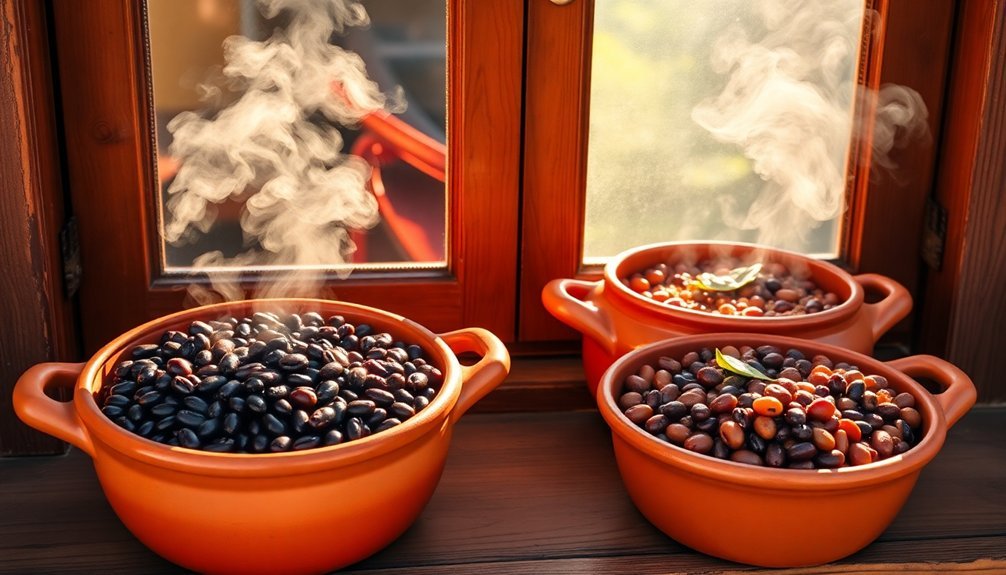
When preparing earth vessels for spice infusion, you'll need to focus on both sterilization and mechanical agitation processes. Start by preheating the vessel's walls with steam to prevent condensation, then apply negative pressure to facilitate product transfer.
Once you've sealed the vessel, inject sterilizing steam at 5-50 psi while rotating the paddles for even exposure.
You can choose between hot and traditional infusion methods for your spices. The hot method quickly releases essential oils by gently heating spices in oil, while the traditional approach requires several days but yields more intense flavors.
For precise control, you might consider using sous-vide equipment. Remember that different vegetable products require varying temperatures and durations, so you'll need to conduct trials to determine ideal sterilization conditions for your specific ingredients.
Seasonal Spice Adaptations
Beyond the technical aspects of spice infusion, adapting your bean seasonings to match nature's rhythm brings out ideal flavors throughout the year.
You'll want to adjust your spice blends based on the season's unique characteristics and your body's changing needs.
- In spring, focus on light, digestive-friendly combinations using fennel seeds, cumin, and dried mango powder to complement fresh vegetables like peas and fenugreek leaves.
- During summer, incorporate cooling blends with coriander and Panch Phoron, while adding tropical elements through Aamchur Masala.
- When monsoon arrives, shift to earthy, comforting flavors centered around fenugreek leaves.
These seasonal adaptations don't just enhance your beans' taste – they'll support your body's natural rhythms and cravings while maximizing the benefits of locally available ingredients throughout the year.
Frequently Asked Questions
Can Solar-Cooked Beans Be Safely Stored Longer Than Traditionally Cooked Beans?
You'll find solar-cooked beans can be stored just as long as traditionally cooked ones – 3-4 days in the fridge when kept in their cooking liquid, but they'll retain moisture and texture better.
Do Metal or Ceramic Containers Affect the Spice Intensity Differently?
Yes, your spices will retain more intensity in ceramic containers since they're non-reactive and provide better sealing. Metal containers can react with spices, causing flavor loss and potentially adding unwanted metallic tastes to your seasonings.
What Role Does Humidity Play in Solar Bean Cooking?
You'll need to manage humidity carefully, as excess moisture creates condensation that blocks sunlight and reduces heat. Opening vents helps control steam but costs temperature, so you'll want to balance ventilation with heat retention.
How Do Moonlight and Nighttime Temperatures Impact Leftover Solar-Spiced Beans?
While moonlight won't affect your leftover beans' flavor, nighttime temperatures can impact their quality. You'll want to refrigerate them promptly to prevent spoilage and maintain freshness, regardless of the moon's presence.
Can Solar Cooking Alter the Nutritional Content of Bean Spices?
Yes, you'll find that solar cooking gently preserves your spices' nutrients while breaking down anti-nutrients. It won't destroy delicate compounds in your seasonings, and the slow heat actually enhances their bioavailability during bean preparation.
In Summary
You've discovered how sun-cooked spices add incredible depth to your beans through natural heat absorption and gradual flavor release. Whether you're using clay pots in summer or adapting your timing for winter months, you'll get the best results by balancing your seasonings with the sun's intensity. Keep experimenting with regional techniques and temperature control – your solar-spiced beans will burst with authentic, aromatic flavors every time.

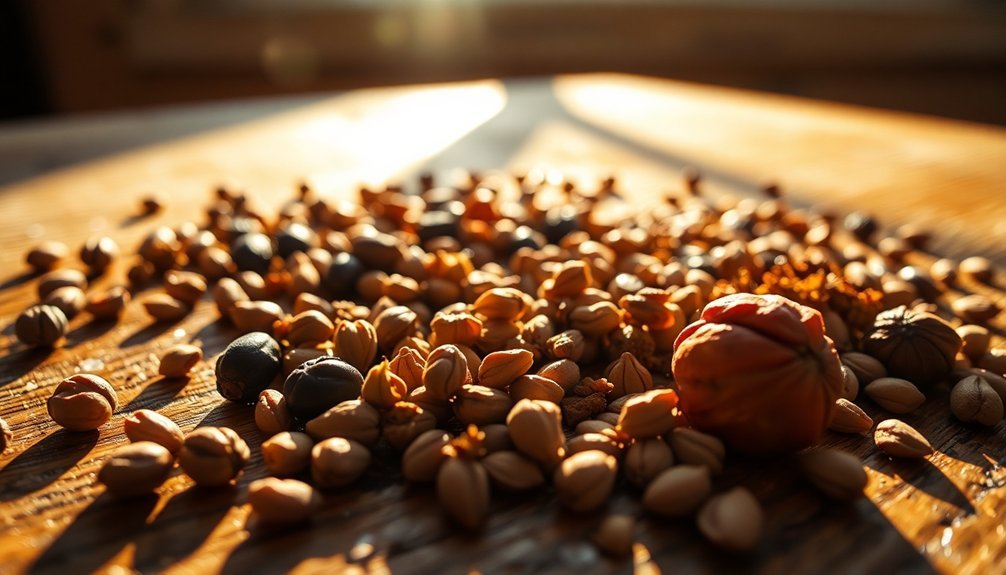



Leave a Reply